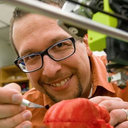Increased Vacuolar ATPase Activity Correlated With CAM Induction in Mesembryanthemum crystallinum and Kalanchoë blossfeldiana cv. Tom Thumb.
Keywords
Abstract
Vacuolar ATPase activities were determined by differential inhibition of homogenates of isolated protoplasts (using the inhibitors molybdate for acid phosphatases, vanadate for plasmalemma ATPase, azide for mitochondrial ATPase, and phlorizin for chloroplast ATPase) and in preparations of isolated vacuoles of Mesembryanthemum crystallinum and Kalanchoë blossfeldiana cv. Tom Thumb. Crassulacean acid metabolism (CAM) was induced in M. crystallinum by NaCl-salinity and in K. blossfeldiana by short-day treatments. Vacuolar ATPase activities increased several-fold during the transition from C(3) photosynthesis to CAM. The increase was quantitatively related to the rates of nocturnal maliacid accumulation in CAM assuming a stoichiometry of 2 H(+) pumped into the vacuole for 1 ATP hydrolyzed and 1 malate(2-) anion transported by secondary flux coupling. In M. crystallinum increased vacuolar ATPase activities were truly correlated with the degree of CAM expressed and not with NaCl accumulation due to the salinity treatment. Some properties of the vacuolar A TPase of M. crystallinum characterized in vacuole preparations were a pH-optimum near 8.0, an apparent K(m) (MgATP(2-)) of 0.20 to 0.29 mM, and an approximately 70 % inhibition by 50 mM nitrate.


